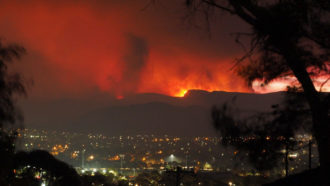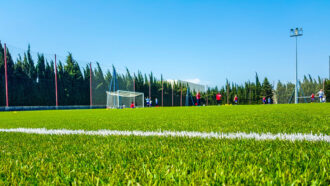The best defense is a good snow fence
Science fair superstar Erica David shows how fences that trap snow can help the environment.
By Emily Sohn
If you’re a loyal reader of Science News for Kids and you’re interested in science fairs, you may already know about 17-year-old Erica David. And even if you haven’t heard of Erica yet, you’ll probably be interested in this science fair champ’s story.
For the past 6 years, Erica has been traveling all over the country, winning prizes at science fairs for her continuing research on fences that catch snow. Snowy states like Wyoming have long used wooden snow fences to stop blowing snow from covering highways. Wide drifts form behind the fences instead of on the roads.
Over the years, starting in sixth grade, Erica has designed and built fences that trap more snow than current models. (See Snow Traps).
Thanks to the strength of her work, Erica competed twice in the Discovery Young Scientist Challenge (DCYSC) for top middle school science fair winners. This year, she made her third trip to the prestigious Intel International Science and Engineering Fair (ISEF) for high school science superstars.
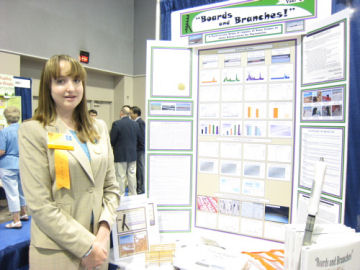 |
|
Erica David shows off the results of her work at the 2007 International Science and Engineering Fair in Albuquerque.
|
| Emily Sohn |
I caught up with Erica at ISEF in Albuquerque, N.M. in May, where she won a third-place award of $1,000 for Year 6 of her ongoing project. Soon to be a senior at Pinedale High School in Wyoming, Erica has presented her studies at international conferences. She’s currently working with business executives and government officials to see how snow fences might help the environment.
“This year, I expanded my project to work in the real world and apply my research,” Erica says.
A disturbance in the field
Erica lives near Wyoming’s Jonah natural gas field, where the EnCana oil company drills for fuel. Unfortunately, the drilling disturbs plants and animals, and EnCana is looking for ways to repair the environment after drilling begins. Maybe, Erica thought, snow fences could help. She contacted EnCana and asked them whether she could test her ideas.
She was particularly interested in restoring the area’s lost sagebrush, a plant that normally blankets the land there. Sagebrush is naturally abundant in dry environments like Wyoming’s desert, but it still needs some water to grow.
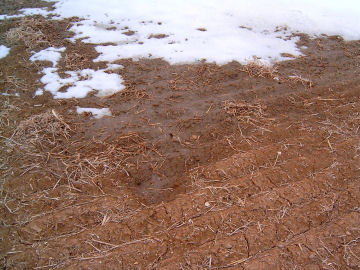 |
|
By trapping snow in piles, snow fences allow patches of the white stuff to linger longer into the springtime.
|
| Erica David |
By strategically using fences to create snowdrifts, Erica suspected that she could increase moisture in the soil through the dry spring and summer. More moisture would give sagebrush seedlings a better chance of surviving. Such a plan would be cheaper and easier than building elaborate networks of tubes and pumps to carry water.
Snow-catching strategies
Erica tested four fence strategies throughout the gas field to see which would catch the most snow. In one area, she set up the wooden fences she had designed in previous years. These structures have evenly spaced horizontal boards stretched between two vertical posts.
In three other areas, she used a new type of fence, called a snow snake fence. These orange, plastic, weblike structures catch less snow than the wooden fences, but Erica thought they might help distribute snow into smaller, but more even, piles. In one of these sections, she placed just one snow snake fence. In another, she put one snow snake fence 18 meters (59 feet) behind another.
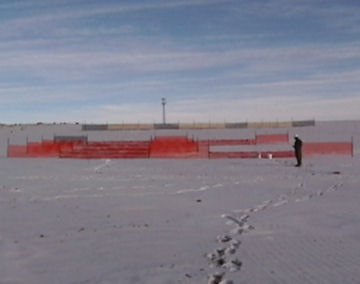 |
|
Erica checks on the snowdrifts forming behind her snow-fence systems.
|
| Courtesy of E. David |
In the final arrangement, she placed four snow snake fences in a row, 6 meters (20 feet) apart. For this system, she also put a wooden fence at the highest point of the plot. Erica suspected that trapping more snow on higher ground would make the melting snow run downhill in the spring and add extra moisture to the soil.
The results are in
Every winter weekend, Erica measured the volume, depth, and density of the snowdrifts accumulating behind her fences. The combination of regular and snow snake fences, she found, created the largest and most evenly distributed snowdrifts.
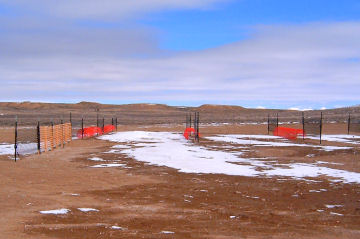 |
|
A combination of wooden fences and snow snake fences trapped the most snow, Erica discovered.
|
| Erica David |
But do bigger snowdrifts actually lead to moister soil? To find out, Erica has been testing the dirt underneath the drifts. Across her study sites, she has pounded 200 narrow tubes about a meter (3 feet) deep into the ground.
Erica keeps the tubes sealed until she arrives to take her measurements. Then, she uses a device that sends electricity into the soil. The amount of water in the dirt determines how well the signal travels through it, and the probe gives moisture percentages from several depths.
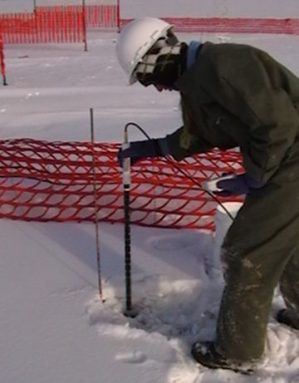 |
|
Bundled up against the chill, Erica uses an electronic device to measure moisture in the soil beneath snowdrifts.
|
| Courtesy of E. David |
Erica’s results show that deeper and denser snow drifts do lead to moister soil. For every extra cubic inch of snow captured, she found that the moisture in the soil increases by almost 60 percent. Areas under drifts also remain wetter longer into the spring, she says. By February this year, most snow on the Jonah gas field had melted, except in areas where the drifts had piled up behind her fences.
Based on her findings, Erica thinks that snow fences could help revive sagebrush in disturbed areas by adding more moisture to the ground to help seeds sprout.
Erica also checked to make sure that her fences didn’t harm the area’s wildlife in any way. She counted animal tracks in the snow and used automatic cameras to show that her fences did not disturb wild animals. In fact, the structures might actually provide hiding places for rabbits and other creatures. This year, she will also see whether migratory animals tolerate the fence setups as well as native animals do.
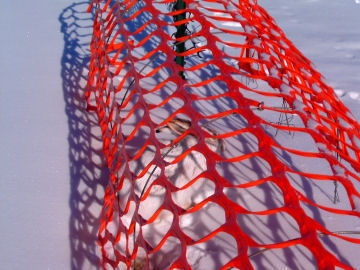 |
|
This white rabbit has found refuge beneath one of Erica’s snow snake fences.
|
| Erica David |
From her half-dozen years on the science fair circuit, Erica has learned just as much about communicating as she has about science, she says. At the International Snow Science Workshop in Telluride, Colo., in October 2006, for example, she presented her research in front of some 800 snow scientists. She came home inspired to continue her work.
“[The scientists] were very excited and interested to see high schoolers working at such a high level,” she says. “This study has ignited my passion for the environment and engineering.”


